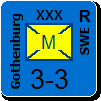wosung
Posts: 692
Joined: 7/18/2005
Status: offline

|
German Panzer-, Light divisions: Generally German mobile and even Infantry divisions had quite different quality, microstruktures and equipment. From pre-war time to 1945 they were formed in 33 mobilization waves ("Wellen"), from standing army units to reinforcement battalions to Landwehr units.
Panzer-, Light- and Motorized divisions formed quite a distinct entity, but every one of this three types in it self was not uniform. Plus their organization changed through the war.
The 6 Panzer Divisions in 1939 (the 10 Panzer Divisions in 1940) consisted each of 1 Panzer Brigade of 2 Panzer regiments of 2 battalions ("Abteilungen") each with altogether theoretically 561 Panzer (servicable average around 320 Pz I, II, 35t, 38t, and a few III and IV) plus 2 motorized Infantry regiments of 2-3 battalions each and other troops.
The 20+ Panzer Divisions in 1941 consisted each of only 1 Panzer regiment (11 with 2 battalions, 9 with 3 batallions) each with around 150 Panzer (altogether 3.671 on Eastern Front in June 1941, same types as before, but now around 1.000 Pz III and 479 Pz IV spread in between all Panzer Divisions) 4-6 battalions of motorized infantry (sometimes the first battalion was armoured, gepanzert, with SdKFZ 251 personnell carriers). Equipment was heterogenuous: In 1941 one of the Panzer Divisions had 96 typs of personnel carriers, , 111 typs of trucks, and 37 different motorcycles, all robbed in all of Western Europe. In October 1942 10 of the Panzer Divisions consisted only of one Panzer battalion plus supporting units. In March 1942 Eastern Front Panzer Divisions consisted of 1.503 Panzer altogether (140!! servicable altogether).
The Panzer Division 1943 theoretically consisted of 1 Panzerregiment of 2 battalions (altogether theoretically around 160 Panzer).
The Panzer Division 1945 theoretically consisted of only 1 Panzerbattalion (Pz. IV, V) plus 1 armoured anti-tank battalion (StuG, Jagdpanzer). In 1944-45 Panzer strenghts were around 4-5.000 at the Eastern Front and perhaps 500-1.000 in France and Italy. In practice most Panzer Divisions had around 20-60 serviceable Panzer.
Motorized Divisions and later on Panzergrenadier Divisions consisted of 1 Panzer or assault gun battallion, and 2 motorized Infantry regiments with altogether 6 battalions. SS Panzer Divisions were organized pretty much on the lines of ordinary Panzer Divisions. Additionally the often had 2 extra Panzer Grenadier battallions, a whole battallion of assault guns, and around 25% more men and equipment.
The 4 light divisions (1.-4.) were formed in 1937-8 as motorized cavalery divisions with varying organization, usually a light tank regiment or battallion, 1-2 cavalry regiments and supporting troops. After the Polish campaign they were upgraded. In October 1939 the 7. Panzer Division was formed from the 3. light division. In February 1940, when Rommel took over, it consisted of 3 Panzer and 6 mot. rifle battalions plus support troops and 218 Panzer (more than 50% 35t., 38 t., the rest Pz. III-IV). In late 1940 4 Infantry Divisions were redesigned as light Divisions (5.-?), although their org first was still basically that of an Infantry division. In 1941/42 the 90. and 164 light (Africa) division was formed from units already in Africa. In March 1943 the Motorized were renamed to Panzergrenadier Divisionen.
Altogether Germany formed 38 Panzerdivisionen (1.-27., 116., Panzer-Lehr, Großdeutschland, Hermann Göring, 1.-3. SS, 5. SS, 9.-10. SS, 12. SS.)
plus 12 rump Panzer Divisions in regimental strength (232.-233., Norwegen, Kurmark, Holstein, Jüterborg, Münchenberg, Clausewitz, Donau, Schlesien, Thüringen, Westfalen),
29 Motorized/Panzergrenadier-Divisonen (2.-3.mot., 10. mot., 13.16. mot., 18.mot. 20. mot., 25. mot., 29. mot., 36. mot., 60. mot., Brandenburg, 1.-5. SS, 9.-12. SS, 16.-18. SS, 23. SS, 34. SS.)
plus 7 Panzer Grenadier Divisionen in regimental strength (26.-28., 32., 38. SS, Führer Grenadier)
A short last note to the Japanese SNLF forces: Some? of them were named after naval stations ("Kobe" Yokosaka...). Some of them had more in common with USMC defense battalions then with Marine divisions.
References:
John Ellis, World war 2: a statistical survey, p. 129-30, 204-6, 230-1.
Andrew Mollow, The armed forces of World War 2, p. 6-12, 107-8, 185-6.
The Oxford companion to the Second World War, p.469-472.
David Fraser, Rommel, p. 160.
Karl Walde, Guderian, p. 178-9, 187-8.
James Lucas, Handbuch der Wehrmacht, p. 91-118.
|
 Printable Version
Printable Version




 shock that... as Mziln the SNLF were the 'marines' for the japanese.
shock that... as Mziln the SNLF were the 'marines' for the japanese. 

 Oops, I hope it did not look like I did them
Oops, I hope it did not look like I did them  It was not my intention anyway ;)
It was not my intention anyway ;)



 New Messages
New Messages No New Messages
No New Messages Hot Topic w/ New Messages
Hot Topic w/ New Messages Hot Topic w/o New Messages
Hot Topic w/o New Messages Locked w/ New Messages
Locked w/ New Messages Locked w/o New Messages
Locked w/o New Messages Post New Thread
Post New Thread